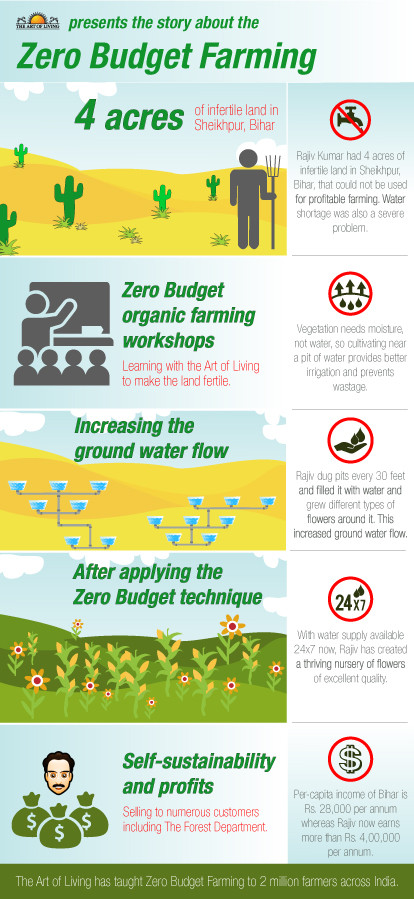Imagine growing fresh, healthy food in your backyard without spending a dime on fertilizers or pesticides. Sounds like a dream, right?
That’s the promise of Zero Budget Natural Farming (ZBNF), a revolutionary approach to agriculture that’s transforming the way we think about growing food. Whether you’re a seasoned farmer or someone curious about sustainable practices, understanding ZBNF could be a game changer for you.
What if you could produce crops without relying on expensive agricultural inputs? This method not only saves money but also restores soil health and enhances biodiversity. It’s all about harnessing nature’s power to grow food naturally. Does this pique your interest? There’s so much more to discover about how ZBNF works and how it can benefit your life and the environment. Stay with us, and you’ll learn everything you need to know to start practicing Zero Budget Natural Farming today.

Principles Of Zero Budget Natural Farming
Zero Budget Natural Farming (ZBNF) is gaining traction as a sustainable farming method that emphasizes self-reliance and minimal external inputs. The principles of ZBNF challenge conventional farming by advocating for practices that naturally enrich the soil and promote biodiversity. Understanding these principles can empower you to create a more sustainable and cost-effective farming operation.
1.Zero External InputsAs the name suggests, ZBNF focuses on avoiding external chemical inputs. Instead, it encourages using resources available on the farm. You can use cow dung, urine, and plant-based formulations to enrich the soil. This not only cuts costs but also reduces your farm’s carbon footprint.
2.Soil RegenerationHealthy soil is the heart of ZBNF. The method promotes practices that naturally regenerate soil fertility. Techniques like mulching and cover cropping protect the soil and improve its organic content. Have you ever noticed how a handful of rich, dark soil teems with life? That’s the goal here—bringing soil back to life.
3.Crop DiversityDiversity is essential in ZBNF. By growing multiple crops together, you create a balanced ecosystem that resists pests and diseases naturally. This approach is not just about planting different crops but also understanding how they interact. Imagine your farm as a thriving community of plants working together.
4.Local Resource UtilizationUtilizing local resources is a cornerstone of ZBNF. This means making use of what is readily available in your immediate environment. From seeds to fertilizers, everything you need can be sourced locally. This not only supports your local economy but also ensures that your farm is more resilient.
5.Animal IntegrationAnimals play a critical role in ZBNF. Cows, in particular, are cherished for their contributions to soil fertility. Their dung and urine are key components in natural fertilizers. Have you considered how integrating animals might not only benefit your farm but also create a more harmonious farm life?
By embracing the principles of Zero Budget Natural Farming, you not only contribute to a healthier planet but also create a sustainable livelihood for yourself. Are you ready to transform your farm into a thriving, self-sustaining ecosystem?

Key Practices And Techniques
Zero Budget Natural Farming promotes sustainable agriculture without heavy costs. Emphasizing local resources, it reduces chemical dependence and boosts soil health. Techniques like mulching, crop rotation, and natural fertilizers enhance productivity while preserving the environment.
Zero Budget Natural Farming (ZBNF) is gaining popularity among farmers and sustainability enthusiasts. It offers a way to farm without heavy financial investments. The approach hinges on leveraging nature’s own processes and resources. Understanding its key practices and techniques can open up new possibilities for your farming endeavors.Natural Mulching
Natural mulching involves using organic materials like straw, leaves, or grass to cover the soil. This practice helps retain moisture, suppress weeds, and enrich the soil as the mulch decomposes. You can easily gather these materials from your surroundings, making it cost-effective.Bijamrita
Bijamrita is a seed treatment method using cow dung, urine, lime, and soil. It protects seeds from diseases and pests while boosting their growth potential. Imagine preparing your seeds using this natural concoction and witnessing healthier, robust plants sprouting as a result.Jeevamrita
Jeevamrita is a bio-fertilizer made from cow dung, urine, jaggery, and pulse flour. It promotes soil fertility and microbial activity. Adding Jeevamrita to your fields can drastically improve soil health, supporting stronger plant growth without relying on chemical fertilizers.Crop Diversity
Emphasizing crop diversity ensures that your farm remains resilient to pests and diseases. Planting various crops together can create a balanced ecosystem. Think of it as nature’s own pest control, reducing the need for external interventions.Intercropping
Intercropping involves growing different crops in proximity for mutual benefit. It maximizes space and resources while minimizing pest issues. Experimenting with intercropping can lead to surprising results, like increased yields and healthier plants.Rainwater Harvesting
Collecting rainwater is a vital practice in ZBNF. It ensures a sustainable water supply for irrigation during dry spells. Creating simple systems for rainwater collection can save you money and help maintain your farm’s productivity. Are you ready to embrace these techniques? They offer practical ways to enhance your farming without breaking the bank. Consider how each practice might fit into your farming routine and what changes you can make today.Benefits For Farmers And The Environment
Zero Budget Natural Farming (ZBNF) offers numerous benefits for both farmers and the environment. This sustainable approach emphasizes the use of natural resources, reducing the need for chemical inputs. By adopting ZBNF, farmers can experience improved soil health, increased biodiversity, and enhanced crop resilience. These changes not only boost agricultural productivity but also foster a harmonious relationship with nature. Let’s explore the specific advantages that ZBNF brings to both farmers and the environment.
Improved Soil Health
ZBNF practices enhance soil fertility naturally. Organic matter, such as crop residues and animal waste, enriches the soil. This boosts its nutrient content and improves structure. Healthy soil retains moisture better, reducing irrigation needs. It also supports beneficial microbes, essential for plant growth.
Cost Savings For Farmers
Adopting ZBNF reduces farming costs significantly. Farmers spend less on chemical fertilizers and pesticides. Instead, they use local resources, which are often free. This cuts expenses and increases profit margins. Farmers also avoid debt, as they rely less on costly inputs.
Enhanced Biodiversity
ZBNF encourages biodiversity on farms. Diverse crops and trees create habitats for various species. This leads to natural pest control, reducing the need for chemicals. Birds, insects, and animals thrive in this environment. This biodiversity supports a balanced ecosystem.
Reduced Environmental Impact
ZBNF practices decrease pollution and carbon emissions. Without chemical inputs, water sources remain cleaner. Soil absorbs more carbon, mitigating climate change. This sustainable approach helps preserve the environment for future generations.
Increased Crop Resilience
Crops grown under ZBNF are more resilient to stress. Natural farming methods improve plant health and strength. Crops are better equipped to withstand droughts and pests. This ensures stable yields, even in challenging conditions.

Challenges And Criticisms
Zero Budget Natural Farming faces challenges like skepticism about effectiveness and scalability. Critics question its adaptability across diverse climates and soil types. Concerns about yield consistency and farmer training also arise.
Zero Budget Natural Farming (ZBNF) has gained attention as a sustainable farming practice that promises to minimize costs and maximize yield. However, like any agricultural method, it faces its share of challenges and criticisms. Understanding these can help you make informed decisions if you’re considering this approach for your farm.Implementation Challenges
Adopting ZBNF isn’t as simple as flipping a switch. Farmers often face hurdles in the transition from conventional methods. You might find it challenging to let go of chemical fertilizers and pesticides if they’ve been your go-to for years. Adapting to ZBNF requires a mindset shift. It can take time for the soil and crops to adjust to this natural method. Are you prepared for an initial drop in yield as your farm transitions?Lack Of Scientific Validation
One of the significant criticisms of ZBNF is the lack of extensive scientific research. Critics argue that while success stories exist, there isn’t enough empirical data to support its widespread effectiveness. How do you feel about investing time and resources into something not yet fully validated by science? This lack of scientific backing can make it harder to secure loans or investments. Financial institutions may be wary of funding a method with uncertain returns.Skill And Knowledge Requirements
ZBNF isn’t a one-size-fits-all solution. It requires a deep understanding of natural cycles and local ecosystems. If you’re new to farming, the learning curve can be steep. Are you ready to invest time in learning new skills and knowledge? Your ability to read the land and understand its needs becomes crucial. Unlike conventional methods, ZBNF doesn’t come with ready-made solutions. It demands constant observation and adaptation.Market Access Issues
Even if you’re successful with ZBNF, selling your produce can pose challenges. The market often favors conventional produce due to its uniformity and longer shelf life. How will you differentiate your naturally farmed products to attract buyers? Developing a brand around ZBNF produce might be necessary. This could involve educating consumers about its benefits and ensuring they recognize the value of your products.Resistance To Change
Old habits die hard, especially in farming communities. You might face resistance from peers who are skeptical of ZBNF. It can be daunting to go against the grain when everyone around you is sticking to conventional methods. Creating a support network can be invaluable. Surrounding yourself with fellow ZBNF practitioners can provide encouragement and share practical solutions to common problems. Navigating the challenges and criticisms of ZBNF can be daunting. But if you’re passionate about sustainable agriculture, this could be a rewarding path. What’s your take on these challenges? Are you ready to embrace the risks for a potentially greater reward?Conclusion
Zero Budget Natural Farming offers a sustainable way to grow crops. It reduces costs and benefits the environment. Farmers can use natural resources without spending much. This method promotes healthy soil and better yields. It supports biodiversity and reduces chemical use.
For those interested in farming, it’s worth considering. Simple techniques and local materials make it accessible. Start small and observe the changes. Learning from nature can lead to long-term success. Embracing this approach can help the planet and your pocket.
Try it and see the difference in your farm.


